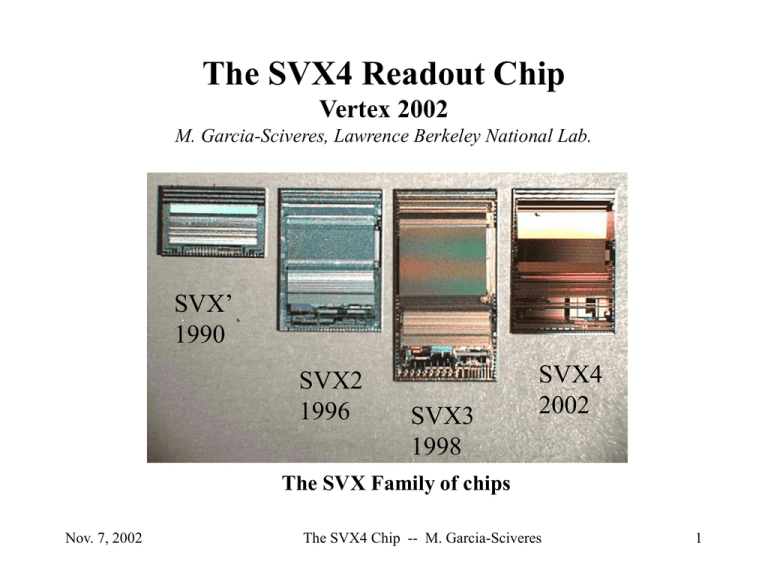SVX4 chip
advertisement

The SVX4 Readout Chip Vertex 2002 M. Garcia-Sciveres, Lawrence Berkeley National Lab. SVX’ 1990 SVX2 1996 SVX3 1998 SVX4 2002 The SVX Family of chips Nov. 7, 2002 The SVX4 Chip -- M. Garcia-Sciveres 1 Credits & History • Design Team: – LBNL: Brad Krieger (lead designer), Jean-Pierre Walder (ADC), Henrik von der Lippe (I/O pads), Emanuelle Mandelli (full chip simulation) – FNAL: Tom Zimmerman (preamp & pipeline), Jim Hoff (pipeline logic) – U. of Padova: Stefania Alfonsi (FIFO) • Timeline – July 2000: First SVX4 proposal meeting following studies at LBNL – May 2001: Common CDF/D0 specifications supplied to designers. Preliminary design review. – October 2001: Final Design Review – April 2002: Design submitted for fabrication – June 10, 2002: Wafers delivered to FNAL – June 12, 2002: First chip tested at LBNL, basic functionality verified. Nov. 7, 2002 The SVX4 Chip -- M. Garcia-Sciveres 2 Why SVX4? • Present CDF and D0 detectors not expected to survive beyond 4-6 fb-1 • Noise increase in SVX3 and SVX2 chips is important limitation on lifetime • Not possible to re-order existing chips to build new detectors • Take advantage of new Quarter Micron technology and work done for LHC experiments. • Functionally, SVX4 ~ = SVX3 + additional interface logic to make it optionally heave like SVX2 chip. Nov. 7, 2002 The SVX4 Chip -- M. Garcia-Sciveres 3 Review of SVX3 (presented at Vertex 1998) ADC 8 Charge sensitive amplifier with adjustable risetime Dual-ported analog pipeline for dead-timeless operation Wilkinson Zero-suppressed type ADC 128 channels readout on 8-bit parallel bus in parallel • Low resistivity substrate exploited for ground distribution and digital/analog isolation • Real time pedestal subtraction built into ADC Nov. 7, 2002 The SVX4 Chip -- M. Garcia-Sciveres 4 SXV4 features • Use same floor plan as SVX3 • Most analog circuits redesigned at schematic level- full custom layout • Digital circuits made using library parts from rad-hard library developed for ATLAS pixel chip, based on RAL quarter micron library. • Use low resistivity substrate as in SVX3 • Add on-chip decoupling capacitance • Design relies heavily on fantastic accuracy of high volume commercial process simulation tools – this is THE biggest change relative to traditional rad-hard electronics. Nov. 7, 2002 The SVX4 Chip -- M. Garcia-Sciveres 5 Results • Full SVX4 chip was simulated before submission. The problem is no longer “can you simulate it” but rather “what to simulate”. • First full size chip fabricated is essentially a usable chip: The number of changes needed for the next SVX4 submission is less than the number of changed made for the SVX3 production run. • The things that need to be fixed were not caught by the simulation because the right things were not simulated. • Every item could be simulated after the fact, including a very subtle ADC effect (shown later). • Radiation tolerance to spare. SEU x-section lower than SVX3- same register cells as ATLAS but 100 times fewer of them. Nov. 7, 2002 The SVX4 Chip -- M. Garcia-Sciveres 6 Analog performance ENC (electrons) svx3D 4MRad SVX4 10MRad 3500 3000 2500 2000 1500 1000 500 0 0 10 20 30 40 50 Input Capacitance (pF) 100ns integration time, 70ns 0-90% rise time, 290uA/channel preamp current Nov. 7, 2002 The SVX4 Chip -- M. Garcia-Sciveres 7 Zero-Suppressed Data Out “FIFO” • SVX3 “FIFO” is full custom, dynamic logic circuit with asynchronous collapse to achieve zero suppression. • This was the only way to do it fast enough in 0.8mm. • 0.25mm is SO MUCH faster that we could instead use a fully synchronous, automatic place and routed VHDL circuit with no collapse phase- zero suppression happens in real time during readout. • At design readout speed if 53MHz it works exactly except for some special low occupancy hit patterns in which case a single extra readout clock is used. This OK for us. Nov. 7, 2002 The SVX4 Chip -- M. Garcia-Sciveres 8 Full chip Simulation • >300K transistors • TIME-MILL program with some tricks • Save DC points of programmable registers • About 1hr per ms Nov. 7, 2002 The SVX4 Chip -- M. Garcia-Sciveres 9 ADC Comparator channel-to-channel scatter ADC counts (pedestal) Measurement: Each line is a different comparator bias current Less bias More bias Channel number • Pedestal shifts but gain is the same for all traces Nov. 7, 2002 The SVX4 Chip -- M. Garcia-Sciveres 10 ADC scatter cause • All comparators identical at schematic and layout levels. • Quarter micron circuits it turns out are particularly sensitive to tiny threshold mismatch in “matched” (at layout level) transistors. – This is NOT the same thing as lot-to-lot global variations or “corners” • TSMC in fact provides data on this type of mismatch for every transistor parameter (for IBM data comes from a thesis) • With these data one can run a Monte Carlo circuit simulation were the parameters are wiggled for selected transistors. • We wiggled other parameters, not just Vth, but found that Vth is the only one that matters. • Interestingly the ATLAS FE chip was also bitten by this bug, which led to a higher than desired threshold dispersion in current prototype. We copied the MC simulation idea from them. Nov. 7, 2002 The SVX4 Chip -- M. Garcia-Sciveres 11 MC Simulation of Channel-to-Channel Variations ADC counts Ramp-up Pedestal Variation: Measured vs. Monte-Carlo Simulation of Vth Using TSMC Process Data 70.0 65.0 60.0 55.0 50.0 45.0 40.0 35.0 30.0 25.0 20.0 15.0 10.0 5.0 0.0 58 58 23 25 20 17 13 13 6 5.37.2 4uA 10uA Measured SPREAD Simulated, 4 transistor MC Nov. 7, 2002 68 2.22.63.8 16uA Bias current d16_10 d16_4 Measured DELAY Simulated, 4 transistor MC Simulated, all transistor MC Simulated, all transistor MC The SVX4 Chip -- M. Garcia-Sciveres 12 Conclusion • SVX3 circuit was converted to .25mm with some enhancements in a little over 1 year. • SVX4 significantly outperforms SVX3. • Full chip prototype in hand 2 years after first we though of doing it is already closer to a production chip than the final SVX3 prototype was. • Really a new (to us) way to design ICs. Use state of the art industry tools for high volume process. Full chip simulation leading to very high confidence submission. Nov. 7, 2002 The SVX4 Chip -- M. Garcia-Sciveres 13





